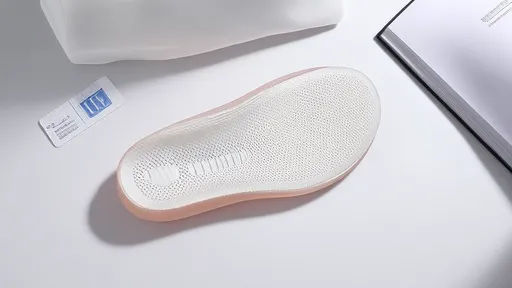For individuals living with diabetes, every step can present unique challenges. Foot care is a critical aspect of diabetes management, and specialized products like diabetic-friendly shoe inserts have emerged as essential tools in preventing complications. These inserts are far more than just cushioned soles—they represent a fusion of medical science and ergonomic design aimed at protecting sensitive feet from the devastating consequences of untreated pressure points and poor circulation.
The Hidden Dangers of Diabetes on Foot Health
Diabetes can silently wreak havoc on foot health through two primary mechanisms: neuropathy and compromised blood flow. Nerve damage diminishes sensation, meaning small irritations like blisters or ill-fitting shoes often go unnoticed until they develop into serious wounds. Simultaneously, reduced circulation slows healing, turning minor abrasions into gateways for infection. This dangerous combination explains why foot ulcers precede approximately 80% of diabetes-related amputations—a staggering statistic that underscores the importance of preventive measures.
Traditional shoe inserts frequently fail diabetic patients because they prioritize comfort over protection. Memory foam, while plush, can create pressure hotspots by conforming too closely to foot deformities. Gel inserts often lack the structural support needed to redistribute weight properly. This is where diabetic-specific designs make their crucial difference—they're engineered to address these very shortcomings.
Engineering Protection: What Makes Diabetic Inserts Different
Premium diabetic inserts employ a multi-layered approach to foot protection. The top layer typically features a moisture-wicking antimicrobial fabric that reduces bacterial growth—a critical feature given that infections pose severe risks for diabetic individuals. Beneath this lies a cushioning layer made from specialized materials like polyurethane foam that provides shock absorption without bottoming out under pressure.
The true innovation lies in the base layer where rigid or semi-rigid arch supports work in tandem with strategically placed metatarsal pads. These components don't just cushion—they actively redistribute pressure away from high-risk areas. Some advanced models incorporate 3D mapping technology to create personalized pressure dispersion based on individual foot scans, offering protection tailored to each wearer's unique foot architecture.
Temperature regulation represents another key differentiator. Many diabetic inserts now incorporate phase-change materials that maintain optimal foot temperature, as both excessive heat and cold can impair circulation further. This attention to thermal management demonstrates how thoroughly designers consider the multifaceted needs of diabetic foot care.
Material Science Breakthroughs Changing the Game
Recent advancements in material science have propelled diabetic insert technology forward. Viscoelastic polymers with "smart" pressure response now adjust their firmness based on both the amount of pressure applied and its duration. This means the insert becomes more supportive during prolonged standing but remains comfortable during casual walking—a dynamic response that static foams can't match.
Another breakthrough comes in the form of breathable composite materials that combine the cushioning properties of foam with the moisture transport capabilities of advanced textiles. These hybrids address two problems simultaneously: reducing shear forces that cause skin breakdown while preventing the humid environment that fosters bacterial and fungal growth.
Perhaps most impressive are the emerging self-monitoring inserts embedded with microsensors. These high-tech versions track pressure distribution in real-time, alerting wearers via smartphone when dangerous pressure patterns emerge. While still in relatively early adoption, such innovations hint at a future where diabetic foot care becomes increasingly proactive rather than reactive.
The Clinical Evidence Supporting Specialized Inserts
Multiple peer-reviewed studies validate the effectiveness of diabetic-specific shoe inserts. Research published in the Journal of Foot and Ankle Research demonstrated a 50-60% reduction in peak plantar pressure when patients used properly fitted diabetic inserts compared to standard alternatives. Another longitudinal study tracking over 1,000 diabetic patients found that those using therapeutic inserts reduced their ulcer recurrence rate by nearly 75% over three years.
Clinicians emphasize that optimal results come from combining quality inserts with appropriate footwear. Even the best insert can't compensate for shoes that are too tight or lack sufficient depth. The most successful patients work with podiatrists or orthotists to create complete foot protection systems—inserts being one crucial component within a broader preventive strategy.
Insurance coverage for diabetic inserts varies widely, but Medicare Part B and many private insurers now recognize their medical necessity, typically covering one to three pairs annually for diagnosed diabetic patients with a doctor's prescription. This growing reimbursement reflects the medical community's acknowledgment of their preventative value.
Selecting the Right Insert: A Buyer's Guide
Navigating the market for diabetic inserts requires understanding several key factors. Depth is paramount—many diabetic inserts are "extra depth" to accommodate foot deformities common in long-term diabetes without creating pressure points. Firmness should be balanced; too soft invites bottoming out, while too rigid may cause new pressure areas.
Seeking professional fitting is ideal, as over-the-counter options may not address individual biomechanical needs. Podiatrists often recommend starting with semi-customizable inserts that allow for some adjustment before progressing to fully custom orthotics if necessary. The break-in period matters too—quality diabetic inserts should be introduced gradually, worn just a few hours daily initially to allow feet to adapt.
Maintenance forms another crucial consideration. Unlike regular inserts that might last years, diabetic versions typically require replacement every 6-12 months as their materials compress and lose protective properties. Some manufacturers now offer subscription services that automatically ship fresh inserts at optimal intervals, removing the burden of tracking replacement schedules.
The Future of Diabetic Foot Care Technology
Emerging technologies promise to revolutionize diabetic inserts further. 3D printing enables hyper-personalized designs that match a patient's exact foot contours and pressure maps. Researchers are experimenting with bioactive materials that could release therapeutic compounds to enhance circulation or prevent infection. Smart inserts with continuous pressure monitoring may soon integrate with diabetes management apps, creating comprehensive health ecosystems.
Perhaps most exciting are developments in regenerative materials that could theoretically help rebuild damaged tissue while protecting feet—though such applications remain in early research phases. What's certain is that as diabetes prevalence grows globally, innovations in preventive foot care will continue accelerating to meet this critical need.
For now, diabetic shoe inserts stand as both a practical solution and a symbol of how targeted product design can dramatically improve quality of life for chronic condition management. They exemplify the marriage between medical insight and everyday utility—a reminder that sometimes, the most profound health interventions come in forms as simple as what we place inside our shoes.

By /Aug 15, 2025

By /Aug 15, 2025

By /Aug 15, 2025

By /Aug 15, 2025

By /Aug 15, 2025

By /Aug 15, 2025

By /Aug 15, 2025

By /Aug 15, 2025

By /Aug 15, 2025

By /Aug 15, 2025

By /Aug 15, 2025

By /Aug 15, 2025

By /Aug 15, 2025

By /Aug 15, 2025

By /Aug 15, 2025

By /Aug 15, 2025

By /Aug 15, 2025

By /Aug 15, 2025

By /Aug 15, 2025

By /Aug 15, 2025